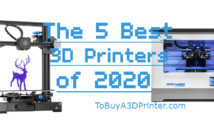3D printing has been around for decades. But only recently has its possibilities as a commercial and consumer technology become apparent. While there are many methods of 3D printing, extrusion printing is one of the most popular.The focus of extrusion 3D printers is molding the filament into your desired object. But what is this filament, how can you choose the best one?
How 3D Printer Filaments Work
First, let’s consider what you can build with a 3D printer. For home use, 3D printers generally are used to create toys and doodads, art and clothes, footwear and jewelry. Commercially, 3D printers are used in a surprising number of applications. This can include building prototypes of parts, 3D models, and even medical bio-printing.
In fact, scientists say that a house built entirely by 3D printer may not be all that far in our future.

Obviously, these different techniques require different types of 3D printing technologies. Printer filaments are most commonly used in extrusion printing. To really understand what printer filament is, you must understand how extrusion printing works.
Basically, the idea behind extrusion printing is similar to squirting cheese out of a Cheez Whiz can, whipped cream out of an aerosol dispenser, or soft serve ice cream out of a soft serve ice cream machine.

A soft plastic substance is extruded (pushed out) from a nozzle. Done multiple times, in multiple layers, this eventually results in an object.
PLA vs ABS: Exploring 3D Printer Filament Materials
Now that you understand how extrusion 3D printing works, lets disscuss the thing that makes it possible: the printer filament. Because without the printer filament, you just have a large box.
Although printer filaments come in several types of materials, two are the most common. These are ABS (Acrylonitrile Butadiene Styrene) and PLA (Polylactic Acid). At first glance, these are pretty similar. Generally sold in coils or spools, they rather resemble heavy-duty fishing line.

You can purchase them in a rainbow of colors, although the neutral ‘natural’ color is the cheapest option. It’s often used in making models or prototypes, or when the finished product will be painted.
Is there a difference between ABS and PLA? Yes, there are many. For one thing, PLA is made from plant-based materials, so there’s less fumes to contend with if you’re working in an enclosed space. ABS is oil-based, so there is a noticeable – and sometimes strong, depending on how long the printer is running – petroleum smell.
Both PLA and ABS are sandable, paintable, and bondable.
Finer detail can be extracted from PLA, but this material can tend toward brittleness and floppy, curled edges. While you don’t need to have a heated printer bed to use PLA, it does benefit from one. A cooling process is also required.
ABS is a bit more flexible, and it does not require a cooling process. However it may crack or warp if you’re not careful about the structure of your object. ABS has a higher melting temperature, and it needs polyimide tape for best adherence. While PLA can adhere to many things.
How Much 3D Printer Filament Do You Need?
This leads us to another question: just how much of filament should you buy? Unlike printer ink, there’s actually a very simple way to determine the volume of 3D printer filament you’ll use. Printing filament is sold by weight, and the objects you make from it will translate directly into weight.
In other words, if you were to buy 1 pound of printing filament, you could expect to make sixteen 1-ounce blocks. Depending on whether your object is hollow, partially filled, or completely solid, you’ll need more or less printing filament per object.
The world of 3D printing is still being explored. And, line by line in this brave new frontier, 3D printer filaments are helping the future take shape.



